14
Charles Mair visiting family in the Benvoulin areaCirca 1921
Benvoulin, British Columbia
 Credits:
Credits:Kelowna Public Archives #3393
15
Benvoulin Hotel and stableCirca 1890s
Benvoulin, British Columbia
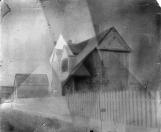 Credits:
Credits:Kelowna Public Archives #10281
16
Kelowna business advertisements in the Kelowna Opera HouseCirca 1909
Kelowna, British Columbia
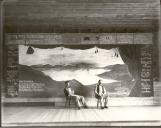 Credits:
Credits:Kelowna Public Archives #902
17
Newspaper article on Sam Elliott's old blacksmith building being demolished4 July 1978
Kelowna, British Columbia
 Credits:
Credits:Kelowna Public Archives
The Daily Courier, July 1978
18
The Vernon and Okanagan Railway Company had planned to build south to the Boundary Country through the Mission Valley, where Benvoulin would become a station site. This line, however, was never built. Instead the Shuswap and Okanagan Railway (completed and opened on May 12th, 1892) ran a branch line from Vernon, three miles to the head of Okanagan Lake at Okanagan Landing, where it connected with the Okanagan steamers. This became the route of travel for both freight and passenger for many years. On May 3rd, 1892 the CPR launched the steamboat S.S. Aberdeen on Okanagan Lake. It stopped three times a week at the wharf in the future Kelowna townsite.19
S.S. Okanagan sternwheeler at Okanagan LandingCirca 1907
Okanagan Landing, British Columbia
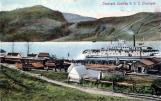 Credits:
Credits:Vernon Museum Public Archives #678
20
Arrival of the S.S. Aberdeen sternwheeler at the Kelowna wharfCirca 1914
Kelowna, British Columbia
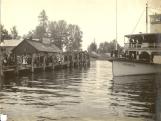 Credits:
Credits:Kelowna Public Archives #3108
21
Bernard Lequime realized the transportation advantages now offered on the Lake. In 1890, he arranged to have the property that he and his brother Leon had recently acquired (Auguste Gillard's original pre-emption in 1863) on the waterfront surveyed. Lequime commissioned J.A. Coryell, C.E. and Company, surveyors from Vernon, to lay out the three hundred acre townsite in 1891. Bernard Lequime was among the few who did not buy into MacKay's sales pitch for Benvoulin becoming the new townsite. Bernard remained convinced that Okanagan Lake would be the preferred travel route in the future. Bernard built a wharf and freight shed nearby in order to ensure Kelowna became a travel stop for the lake boats.On August 13th 1892, Bernard Lequime filed Map 462 with the Registrar General in Victoria. MacKay's Benvoulin townsite plan had already been laid out, but not registered (filed) until September 1892. With MacKay's untimely death on January 1st 1893, the driving force behind the Benvoulin townsite was lost.
22
Portrait of Bernard LequimeCirca 1890s
Kelowna, British Columbia
 Credits:
Credits:Kelowna Public Archives #95
23
Copy of Lequime's Kelowna townsite plan 4621892 original (copy n.d.)
Kelowna, British Columbia
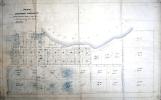 Credits:
Credits:Kelowna Public Archives, #3.07 2005.042.212
24
Many new settlers, mainly British, Scottish and Irish, arrived in the Okanagan Valley looking to buy some land and settle in the new community. George Grant MacKay, with his excellent connections, was able to attract other well-connected people, such as Lord and Lady Aberdeen, Scottish aristocrats interested in Canada. The Aberdeens arrived in Vancouver in October 1890, as part of their cross-Canada tour. The Aberdeens wanted to purchase a holiday retreat in Western Canada and with Lady Aberdeen's brother Coutts Marjoribanks, needing to be relocated from North Dakota, they had someone available to manage it for them.The Aberdeen's had a previous connection with G.G. MacKay, as he had been the engineer in charge of building roads near Lady Aberdeen's ancestral home in Inverness-shire. When the Aberdeens arrived in Vancouver, they re-established contact with G.G. MacKay, who was well established in the real estate business in Vancouver. As the couple had little time to look at property during their short stay, they asked MacKay to act on their behalf and purchase property. MacKay's first suggestion was the Fraser Valley, which at $50-$60 per acre was deemed to be too costly. MacKay's second suggestion was the Mission Valley, selling to the Aberdeens some of the land he had bought on speculation and was planning to subdivide. The Aberdeens bought the 480 acre McDougall homestead, with MacKay's assurances that a new railway would soon be built through the area and would therefore increase the property's value tenfold from its original purchase price of $10,000. This enticed the couple to purchase the property sight unseen. Coutts Marjoribanks, with the help of a friend and the new ranch manager, had a new house built, in the Indian colonial bungalow style. Lady Aberdeen renamed the property Guisachan ('Place of the Fir' in Gaelic) after her childhood home in Inverness-shire, Scotland.
25
View of the Aberdeen Ranch in the Okangan Mission ValleyCirca 1892
Okanagan Mission Valley, British Columbia
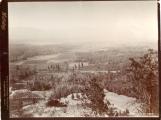 Credits:
Credits:Kelowna Public Archives #8426
Charles W. Holliday (photographer)
26
Hunting party in front of Guisachan HouseCirca 1890s- early 1900s
Guisachan Ranch, Okanagan Mission, British Columbia
 Credits:
Credits:Kelowna Public Archives #3121